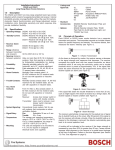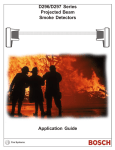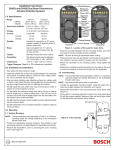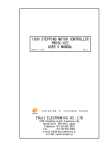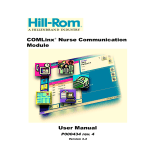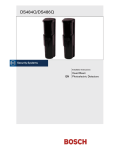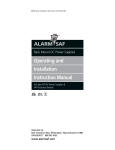Download Bosch 1943 LED Specifications
Transcript
D296/D297 Installation Instructions EN Long-Range Beam Smoke Detectors D296/D297 | Installation Instructions | 1.0 Description FCC Compliance Notice 2.0 This equipment was tested and complies with the limits for a Class B Digital Device, pursuant to Part 15 of the Federal Communications Commission (FCC) rules. These limits provide reasonable protection against harmful interference in a residential installation. Each D296 and D297 Transmitter sends an invisible infrared beam of a specific frequency and intensity. Each D296 and D297 Receiver detects and measures the beam’s intensity (refer to Figure 1). This equipment generates, uses, and can radiate radio frequency energy. If not installed and used according to the manufacturer's instructions and recommendations, this equipment might cause harmful interference to radio communications. There is no guarantee that interference will not occur in a particular installation. If this equipment does cause harmful interference to radio or television reception, determined by turning the equipment on and off, try correcting the interference by doing one or more of the following: • Reorient or relocate the receiving antenna. • Increase the separation between the equipment and the receiver. • Connect the equipment to an outlet on a circuit different from the receiver. • Contact the installing company or an experienced radio or TV technician for help. The FCC booklet How to Identify and Resolve Radio-TV Interference Problems (stock number 004-000-00345-4) can be helpful. It is available from: Operation Figure 1: Infrared Transmission 1 3 2 1 - Transmitter 2 - Beam As smoke obscures the beam, the receiver senses a decrease in the signal strength and measures that decrease. The receiver compares the signal level with two preset thresholds: an alarm threshold that is set using the sensitivity switch and a trouble threshold that is preset at approximately 10%. If the signal falls below the alarm threshold for the programmed alarm period, the receiver signals an alarm (refer to Figure 2). Figure 2: Beam Obscuration 1 4 2 U. S. Government Printing Office Washington, DC 20402 1.0 3 - Receiver 3 Description The D296 and D297 Long-Range Beam Smoke Detectors have a separate transmitter and receiver. Internal pointability provides coverage flexibility without brackets. Automatic signal synchronization and range adjustment reduce installation costs. Selectable sensitivity and alarm response time provide installation flexibility. 1 - Transmitter 2 - Beam 3 - Obscuring object 4 - Receiver If the signal falls below the trouble threshold for more than 20 sec (caused by an object blocking the beam for example), the receiver signals a trouble condition (refer to Figure 3). Figure 3: Beam Blockage 1 4 2 3 1 - Transmitter 2 - Beam 2 3 - Blocking object 4 - Receiver Bosch Security Systems, Inc. | 09/06 | 31344F D296/D297 | Installation Instructions | 3.0 The receiver automatically compensates for the gradual signal loss because of dust and dirt buildup on the cover. After a signal loss of 50%, the receiver indicates a trouble. When the dust and dirt buildup are cleaned or the blockage is removed, the detector automatically returns to its normal operation level. The receiver indicates a trouble if the beam strength increases by more than 20% for longer than 20 sec. A trouble can be caused by an initial misalignment or the removal of a partial beam blockage during alignment. Perform a fine-tune alignment as described in Section 6.3 Fine-Tune Alignment on page 8. 3.0 Installation Considerations Correct D296 and D297 location and spacing is critical in a properly installed and operating fire alarm system. For best results, place the detectors and space them according to the National Fire Protection Association (NFPA) Standard 72, The National Fire Code. This standard is available at a nominal cost from: NFPA Protection Association Batterymarch Park Quincy, MA 02269 In all installations, good engineering judgement must prevail. • Do not use mirrors. Install detectors with a clear line-of-sight between the transmitter and receiver. • Clear the beam path of moving objects. • Set sensitivity based on the distance between the transmitter and receiver (refer to Section 6.2 Sensitivity Adjustment on page 8). • Mount detectors directly to the ceiling or to side walls. Do not mount them where the beam path runs parallel within 4 in. (10.2 cm) of a corner. • For a sloped or peaked ceiling, ensure the beam path is within 3 ft (1 m) of the ceiling’s peak. • Air stratification might prevent smoke from reaching detectors mounted close to the ceiling. Stratification occurs when smoke, rising because it is warmer than the surrounding air, reaches a level where it is the same temperature as the surrounding air and does not rise to the ceiling. If this is possible, install extra beams where stratification is expected. • Avoid areas with normal smoke concentrations, such as kitchens and garages. • Do not install detectors where the normal ambient temperatures are below -22°F (-30°C) or above +130°F (+54°C). Bosch Security Systems, Inc. | 09/06 | 31344F 3.1 Installation Considerations Avoid Heat and Air Movement Sources • Place the D296 and D297 Detectors where the beam path does not pass near heating and cooling outlets. • Do not mount where hot or cold air blows directly into the beam path. • Heating, ventilating, and air conditioning (HVAC) systems can blow smoke away from the beam path. Smoke must accumulate in the beam path to be detected. • Do not mount heaters close to the beam path. Heat can distort the beam. • Test for beam distortion by monitoring the signal voltage. • After setup, the detector’s signal voltage must read 4 VDC. Monitor the voltage and turn on all heating and cooling devices in the area. The signal voltage must not fluctuate more than 0.20 VDC. If it does, relocate the detector to avoid these disturbances. 3.2 Avoid Bright Light Sources Sunlight and light from extremely bright sources such as the exposed bulbs of high-pressure sodium, mercury vapor, and metal halide lights can cause stray signals. Do not point the receiver toward any of these sources. Sunlight: Do not point the receiver directly at the rising or setting sun. If installing the receiver where sunlight cannot be avoided, mount it slightly higher than the transmitter and aim it down toward the transmitter. This causes the receiver to look below the horizon. Bright Lights: Do not mount the receiver where it looks at exposed bulbs of high-pressure sodium, mercury vapor, and metal halide lights. Refer to Figure 4 to avoid exposed lights. Figure 4: Avoiding Exposed Lights 1 - Receiver 2 - Do not place bright lights in this area. Bare fluorescent lights can also create a problem, especially in long hallways where a series of lights are perpendicular to the beam. Incandescent lights are not a problem as long as they are not directly in the beam path. 3 D296/D297 | Installation Instructions | 3.0 3.3 Installation Considerations Use Correct Wire Gauge and Length Beam smoke detectors are often used to protect large areas, requiring long wire runs to power the detectors and signal alarm conditions. The voltage available at the end of long wire runs might not be sufficient to power the detector, especially when the system is running on battery backup. Use the correct wire gauge when installation detectors. Refer to Table 1 for the proper wire size, wire length, and the number of transmitter and receiver pairs. Table 1: Wire Gauge and Length Wire Length Wire Size 500 ft (152 m) 1000 ft (304 m) 14 AWG (1.8 mm) 20 pairs 10 pairs 16 AWG (1.5 mm) 13 pairs 6 pairs 18 AWG (1.2 mm) 8 pairs 4 pairs 2500 ft (762 m) 5000 ft (1524 m) 4 pairs 2 pairs 3 pairs 1 pair 2 pairs 1 pair 3.4 Provide a Stable Mounting Surface Always select stable mounting surfaces. Beam smoke detectors depend on the projected beam measurement to sense smoke. Trouble or alarm conditions can be caused by shifts in beam alignment when the transmitter or receiver moves. Never mount a detector to a suspended support, such as a pipe or length of wood that is supported at only one end. This type of mounting can create a pendulum effect that greatly multiplies even very small movements at one end of the support. For example, a 2 in. (5.1 cm) movement translates into a beam misalignment of more than 20 ft at 350 ft (6 m at 107 m). Support mounting surfaces at opposite corners to reduce the pendulum effect. Always select surfaces that are not subject to building movement. The D296’s and D297’s automatic compensation circuits eliminate most problems created by normal building expansions and contractions. In some unusual circumstances, the walls and support structure might be subject to more significant movement because of heavy equipment operation, such as cranes anchored to the top of the walls. 4 When you are uncertain about mounting surface stability, measure the detector’s signal voltage. This voltage must be 4 VDC. Beam misalignment can cause this voltage to increase or decrease. The detector indicates a trouble condition when the voltage increases to greater than 4.8 VDC or decreases to less than 2 VDC over a long period. A trouble condition also occurs when voltage decreases to 0.4 VDC for more than 20 sec. Refer to Section 7.3 Reference Voltage Calibration on page 9 for voltage reading. If you expect the mounting surface to move, relocate the detector to a stable surface or add supports to the mounting surface to prevent movement. Mounting the detector to a square or octagonal electrical mounting box of 4 in. (10 cm) can bow the mounting plate. Bowing can occur because the mounting box screw tabs are below flush with the top edges of the mounting box. Overtightening the mounting screws bows the mounting plate inward at the bottom, causing the optics to aim low. Irregularities in the flatness of the mounting box edge surfaces or screw tabs worsens this condition. Only use mounting boxes with flat, regular surfaces and properly formed screw tabs. Tightening the mounting screws to secure the mounting plate to 2 in. (5 cm) or 2 lb (0.9 k) torque minimizes misalignment caused by mounting plate bowing. 3.5 Stratification in Cold Environments Effects In extremely cold environments such as unheated warehouses, smoke cools very quickly and is less likely to rise to the ceiling. Add more detectors at lower mounting heights to compensate. 3.6 Expected Fire Load When designing a fire alarm system, allow for expected fire loads within the application. For example, fires caused by the ignition of flammable petroleum-based liquids generally lead to a rapid buildup of heavy smoke. When this type of fire is probable, use sensitivity settings 0 or 1 for a 5-sec response time. Bosch Security Systems, Inc. | 09/06 | 31344F D296/D297 | Installation Instructions | 4.0 4.0 4. Route the wiring from the electrical box through the wire entrance. Mounting Do not use this product in outdoor applications. 1. Mounting Unpower (disable) all wiring. Install a 10 cm (4 in.) square or octagonal electrical box (not supplied) to a rigid surface that is not subject to movement or vibrations. If you are not mounting these detectors to an electrical box, ensure the surface cannot move or vibrate. For example, do not mount the detector directly to a suspended ceiling without extra support. 5. Mount the back plate to the electrical box. 6. Attach the circuit carrier plate to the back plate using a single mounting screw. 7. Repeat Steps 1 through 6 to mount the transmitter. 2. Remove the screw on the receiver's access door. Then remove the cover’s four screws (refer to Figure 5). Figure 5: Access Door and Cover 2 2 1 1 - Access door 2 - Cover mounting screw (4) 3. Remove the receiver back plate by unscrewing the single mounting screw from the top of the circuit board carrier plate and separating the two plates (refer to Figure 6). Figure 6: Removing the Back Plate 1 2 4 3 1 2 3 4 - Remove screw to expose the back plate. Mounting slot (4) Wiring entrance Do not remove. Bosch Security Systems, Inc. | 09/06 | 31344F 5 D296/D297 | Installation Instructions | 5.0 5.0 Wiring 5.1 Wiring Only apply power after all connections are made and inspected. Refer to Figure 7 and Table 2 when wiring the transmitter and receiver terminals. Figure 7: Wiring a Single D296 or D297 Detector AUX. RELAY ALARM FIRE TRBL ALARM ALARM VDC 4 1 2 3 4 5 6 7 Remote Indicator Plate The D306 Remote Indicator Plate is shipped with the D296 as a standard accessory. Although the D306 is not required, the manufacturer recommends its installation to check the detector’s condition from ground level. If using either a D306 or D307 Remote Indicator Plate, install the remote indicator connector to the receiver now (refer to Figure 8). Figure 8: D306 Remote Indicator Plate Connection 1 – + 8 9 Alarm Loop 2 Power Loop – Power Loop + 1 2 3 4 - 1 2 – + 3 Receiver End-of-line (EOL) resistor Transmitter Fire Alarm Control Panel (FACP) Do not install on verified fire circuits. Do not coil excess wiring inside the units. Table 2: Transmitter and Receiver Terminals Type Terminal Terminal 1 and 2 Receiver 1, 2, and 3 Receiver 4 and 5 Receiver 6 and 7 Receiver 8 and 9 Description Input power terminals. Refer to Section 11.0 Specifications on page 14 for operating voltages. Form “C” auxiliary relay contacts. Terminals 1 and 2 open on Fire alarm; Terminals 2 and 3 close (short) on Fire alarm. Normally Open Fire alarm contacts close (short) on Fire alarm. Normally Closed Trouble contacts open for Trouble alarm. Input power terminals. Refer to Section 11.0 Specifications on page 14 for operating voltages. To reset after a Fire alarm, interrupt power to the receiver for a minimum of 1 sec. If the fire panel does not allow you to reset, install a switch in series with Terminal 8. 6 1 - D306 Remote Indicator Test Plate Connector* 2 - D296/D297 Receiver 3 - EOL 4 - FACP 5 - D306 Remote Indicator Plate Wiring: a = orange c = black e = yellow g = violet b = blue d = red f = green * Refer to Section 7.5 Remote Test Indicator Plate Connector on page 10 for the Remote Test. 1. Place the D307 no farther than 100 ft (30.5 m) from the receiver and wire with 18 AWG (1.2 mm) or larger wire. You can wire the D306 a maximum of 500 ft (152 m) from the receiver. 2. Slide the remote indicator connector over the pins located to the right of the receiver’s terminal strip. Refer to the D307 Installation Instructions (P/N: 32071) if you are connecting a D307. Bosch Security Systems, Inc. | 09/06 | 31344F D296/D297 | Installation Instructions | 6.0 6.0 6.1 Setup Before performing a setup, ensure all connections are made and secure. Then, apply power to the transmitter and receiver. 1. Setup Preliminary Alignment Each optical module has two alignment mirrors, one on each side, for an initial alignment (refer to Figure 11). Figure 11: Optical Module Press the transmitter’s Aim Mode button, located above the green LED (refer to Figure 9) allowing it to power up while the cover is off. 2 1 Figure 9: Transmitter Circuit Board Showing Aim Mode Button 4 3 1 2 1 - Aim Mode button 7 5 2 - Green LED 2. Ensure the green LED flashes on and off. If this LED is off, check for power and proper polarity on Terminals 1 (–) and 2 (+). If the green LED is steadily lit, you have a faulty transmitter. Return the transmitter to the factory. 1 2 3 4 1. Vertical fine tune Front view Horizontal fine tune Side view 5 5 - Alignment mirror (3) 6 - Rear bore sight (2) 7 - Front bore sight Look into either mirror from a side angle that is a minimum of 2 ft (61 cm) from the module. The optical module points at objects seen in the mirror when the orange-colored front bore sight is in the center of the rear bore sights (refer to Figure 12). Use the rear and front sights in the same way as you use sights when aiming a gun. 3. Check the three receiver LEDs (refer to Figure 10). It is normal for all three LEDs to be on at this time, with the green LED either flashing or steadily on. If all LEDs are off, check for power and proper polarity on Terminals 8 (–) and 9 (+). Figure 10: Receiver LEDs - 6 Figure 12: Alignment Mirror 1 2 1 1 - Alarm LED (red) 2 - Trouble LED (yellow) 3 - Normal LED (green) 4. Mount a D309 Strobe Aiming Light or an equivalent, such as a Faraday 5508, as close to the receiver as possible, preferably on top of the receiver. 5. Point the D309 at the transmitter using it as your aiming guide. An aiming light might not be necessary for short distance separations. 1 - Rear bore sight (2) 2 - Front bore sight 2. Rotate the transmitter's optical module left or right until you see the aiming light image (or receiver image, if aiming light is not used) in the mirror. 3. If optical module is initially aimed too high or too low, adjust the Vertical Fine Tuning adjustment Allen screw (with the supplied Allen wrench) slightly up or down until you see the image. 4. Use the Vertical Fine Tuning adjustment screw and the Horizontal Fine Tuning adjustment screw to fine tune the image to the center of the mirror (aligned with the front and rear bore sights). 5. Replace and secure the transmitter's cover. 6. Ensure the transmitter's green LED is flashing. 7. Bosch Security Systems, Inc. | 09/06 | 31344F Replace and secure the transmitter's access door. 7 D296/D297 | Installation Instructions | 6.0 Setup 8. Align the receiver to the transmitter image following Steps 1 through 7. 9. Ensure the receiver's green LED is flashing, indicating the preliminary alignment is complete. 10. If the receiver’s green LED is not flashing, repeat Steps 1 through 9 for the receiver. 6.2 1. 1. Connect the D1005 Test Cable (supplied) to Pins 1, 2, and 3 of P6. These pins are located to the right of the receiver’s terminal strip (refer to Figure 14). Figure 14: D1005 Connection 1 Sensitivity Adjustment Select the appropriate sensitivity setting based on the distance between the transmitter and receiver. (refer to Table 3 which lists distances including some settings that overlap). Select a lower setting for a more sensitive detection or select a higher setting for better immunity to false alarms. Table 3: Sensitivity Settings Switch Setting 0 Sensitivity 30% Alarm Response 5 sec 1 60% 5 sec 2 20% 30 sec 3 30% 30 sec 4 40% 30 sec 5 50% 30 sec 6 60% 30 sec 7 6.3 Fine-Tune Alignment 70% 30 sec a c b 1 - Connector wires (a = white, b = red [+], c = black [-] Beam Length 30 ft to 100 ft (9 m to 31 m) 100 ft to 350 ft (31 m to 107 m) 30 ft to 50 ft (9 m to 15 m) 45 ft to 75 ft (14 m to 23 m) 70 ft to 100 ft (21 m to 31 m) 90 ft to 140 ft (27 m to 43 m) 120 ft to 180 ft (37 m to 55 m) 160 ft to 350 ft (49 m to 107 m) 8* 9* * Do not use positions 8 and 9. They are not valid. 2. Set the receiver’s Sensitivity switch to your selected setting. The Sensitivity switch is located to the right of the optical module. The indicator, or pointer marking, runs along the side of the switches' shaft (refer to Figure 13). If the Remote Indicator Plate connector is installed, temporarily disconnect it. 2. Connect a 20,000 Ω/VDC VOM (or greater) to the D1005’s black (–) and red (+) leads. Set the meter scale so you see the readings ranging from 0 VDC to 5 VDC. 3. Check the three receiver LEDs on the receiver. If the receiver gets the beam, the green LED flashes and the red and yellow LEDs are steadily on. If the green LED is steadily on, the beam is not reaching the receiver. Realign according to the procedure described in Section 6.1 Preliminary Alignment beginning on page 7. 4. Observe the meter readings. Adjust the receiver’s optical module using the horizontal and vertical fine-tuning adjustment screws for a maximum meter reading. This is the most critical alignment process. For the most effective system operation, ensure you have peak voltage during the fine-tune alignment. When performing fine-tune alignment, keep your arms and hands away from the front of the receiver and out of the beam path. Figure 13: Sensitivity Switch 0 The maximum voltage peak reading varies, depending on the distance between the transmitter and receiver. The acceptable peak voltage range is from 0.50 V to 5.00 V. The voltage at the receiver is greater at shorter distances. Make a note of the alignment voltage. It might be helpful if you need to troubleshoot at another time. 8 Bosch Security Systems, Inc. | 09/06 | 31344F D296/D297 | Installation Instructions | 7.0 Peak the voltage to ensure a stable and trouble-free detector. 5. After completing the fine-tune alignment, remove the test cable. 6. Replace and secure the receiver’s cover. 7. Check the status of the receiver’s green LED to ensure it is still flashing. 8. With the meter still connected to the test cable, reinstall this cable to P6. Route the test cable through the opening in the cover (white lead towards center of the receiver). 9. At this point, you can perform an Alarm Test. Connect the D1005’s white and black wires. Reset the receiver by temporarily removing power. 10. Press the receiver’s Setup button, located below the P6 and test cable connection (refer to Figure 15). Additional Information 7.0 Additional Information 7.1 Fire Alarm Reset 1. Reset the receiver after a fire alarm by removing power from the receiver for at least 1 sec. 2. Reapply power (refer to Section 7.4 Power Outage). 7.2 1. Cleaning Clean the outside of the covers a minimum of once each year. Use a common window cleaner and a soft, clean cloth. Under normal conditions, there is no Trouble alarm if the beam is not continuously blocked longer than 18 sec. 2. Recheck the reference voltage. If voltage is less than 3.8 VDC or greater than 4.2 VDC, calibrate the receivers (refer to Section 7.3 Reference Voltage Calibration). Clean covers are necessary for proper reference voltage readings. Figure 15: Receiver Setup Button 1 7.3 2 1 - LEDs 1. 2 - Setup button Only press the Setup button if the covers are on both the transmitter and receiver. A 1-min to 2-min automatic internal setup process begins. This setup ends in a reference voltage that is used to measure beam blockages. The red and yellow LEDs turn off and the green LED turns steadily on. After some voltage fluctuations, the meter sets to 5.0 VDC. During this time, do not block the beam or move the units. 11. At the end of the setup, the receiver’s green LED flashes and the voltage decreases to a range from 3.8 VDC to 4.2 VDC. Use this voltage as a reference when you compare later readings to determine the need for cleaning. If the voltage is not within this range, press the Setup button. Reference Voltage Calibration Check the detector’s reference voltage a minimum of once each year. Check the voltage more often if required by local regulations or AHJs. 2. Remove the receiver access door and measure the reference voltage using the supplied test cable. You can also measure the voltage at the D307 (if used). 3. If the voltage is less than 3.8 VDC, remove the cover and use the Setup switch to perform a fine-tune alignment. If the voltage is greater than 4.2 VDC, press the Setup button. You do not need to calibrate if the voltage is between 3.8 VDC and 4.2 VDC. 7.4 Power Outage When power is removed and reapplied to the receiver, such as in a power outage or alarm reset, the original reference voltage information is lost. If the cover is on during powerup, the receiver automatically restarts the internal setup process for a new reference voltage when power is applied. If the cover is off, reattach it and press the Setup button. 12. After setup, remove the test cable. 13. Reconnect the D306 connector if used. 14. Replace and secure the access door. Bosch Security Systems, Inc. | 09/06 | 31344F 9 D296/D297 | Installation Instructions | 7.0 7.5 1. Additional Information Remote Test Indicator Plate Connector Momentarily attach the connector’s orange and black leads to produce a Test alarm (refer to Figure 16). For example, if the expected smoke density is 0.5%/ft (0.5%/30 cm), the obscuration at 50 ft (15 m) is 20%. The obscuration at 250 ft (95 m) is 73% (refer to Figure 17). Figure 17: Smoke Density and Obscuration Chart Figure 16: Remote Indicator Plate Connector 1 2 3 4 5 6 1 2 3 4 5 6 - Remote Alarm Test (orange wire) Analog reference voltage out (blue wire) Common (-) (black wire) Red LED (red wire) Yellow LED (yellow wire) Green LED (green wire) 2. For a Remote Test, install a momentary switch between the orange and black wires. 3. Connect the black and blue wires to an analog meter for reference voltage measurements. 4. Connect the red, yellow, and green wires to remote LEDs. Each lead wire is current limited to a maximum of 10.0 mA DC. 7.6 Smoke Density and Obscuration The total obscuration of the infrared beam depends on the density and width of the smoke cloud along the beam path. As the width of the smoke cloud increases, less dense smoke is needed for an equal obscuration of the beam path. Assume the smoke cloud is the entire distance of the beam path. Select the total obscuration needed for an alarm by setting the Sensitivity Pot according to Section 6.2 Sensitivity Adjustment on page 8. 1 2 3 4 - Smoke density UL minimum sensitivity UL maximum sensitivity Distance between transmitter and receiver Refer to Table 4 for the sensitivity pot settings, total obscuration, needed for an alarm. Table 4: Sensitivity Pot and Obscuration Sensitivity Pot Setting Total Obscuration at Alarm 2 0 or 3 4 5 1 or 6 7 20% 30% 40% 50% 60% 70% Total beam obscuration by smoke increases with the distance between detectors; there is more smoke within the beam path. Therefore, you can lessen detector sensitivity by increasing the distance. Detector sensitivity is also less at greater distances because obscuration by other contaminants, such as dust, increases. Set detector sensitivity to respond to the proper smoke obscuration and to reduce the chance of a false activation. 10 Bosch Security Systems, Inc. | 09/06 | 31344F D296/D297 | Installation Instructions | 7.0 7.7 Additional Information Field Sensitivity Measurements The D296 and D297 automatically compensate for the effects of dust and dirt accumulation on their covers. They also compensate for component aging. The NFPA requires the detector sensitivity be measured in the field within one year after its initial installation and every alternate year thereafter (refer to NFPA 72). Order a D308 Test Kit to test detector sensitivity in the field. Refer to Table 5 for alarm information for the D308 filters and the Sensitivity Test Kit provided with the detectors. Table 5: Sensitivity and Response Sensitivity Setting Must Not Alarm Must Alarm 2 0 or 3 4 5 1 or 6 7 0% (no filter) 0% (no filter) 20% (filter) 20% (filter) 40% (filter) 40% (filter) 40% filter 60% filter 60% filter 80% filter 80% filter 80% filter Use the Sensitivity Test Kit to check detector sensitivity only during installation. For field testing, use the D308. Each filter decreases the detector’s signal by a specific amount. When you place a filter in front of the receiver’s optical module for a minimum of 30 sec (5 sec for position 0 or 1), you can determine the approximate sensitivity setting of the installed detector by its response as shown in Table 5. Testing these detectors activates a Fire alarm. Inform all concerned personnel before performing a test. Bosch Security Systems, Inc. | 09/06 | 31344F 11 D296/D297 | Installation Instructions | 8.0 8.0 Troubleshooting Troubleshooting Table 6: Troubleshooting Transmitter LED Condition Solution Flashing Normal Off 1. There is no power at the transmitter. 1. Restore power to Terminals 1 and 2. 2. The Aim Mode button not pressed. 2. Press the Aim Mode button. 3. The transmitter is faulty. 3. Replace the transmitter. Receiver – Aim Mode Red Yellow Green Terminals Terminals Condition Solution LED LED LED 4 and 5 6 and 7 On On Flashing Open Open The alignment is acceptable. On On On Open Open The beam is blocked or the Clear the beam path or receiver is misaligned. realign the receiver. On Flashing Flashing Open Open The sensitivity setting is invalid. Set the receiver to the proper setting. On Off Off Open Open There is no power. Check for power at Terminals 8 and 9. Receiver - Normal Mode Off Off On Open Closed The receiver is initializing. It stabilizes in 60 sec to 120 sec Off Off On Open Open The receiver is initializing. The Replace the access access door is missing or door. loose. Off Off Flashing Open Closed Normal. Off Off Flashing Open Open The access door is missing or Replace the access loose. door. Off On On Open Open Trouble. Beam is blocked or Clear the beam path or misaligned. realign the receiver. Off On Flashing Open Open Trouble. If the reference voltage Clean the transmitter is less than 2 VDC, dust on the and receiver covers. If lens reduced the signal the reference voltage strength or vibration misaligned does not return to 4 VDC, realign the receiver the receiver. and press the Setup switch. Off On Flashing Open Open If the reference voltage is Perform a fine-tune greater than 4.8 VDC, the alignment of the receiver beam strength increased and use the Setup because an initial beam button. misaligned or a partial blockage was removed at setup. On Off Flashing Closed Closed Alarm. Determine the cause of the alarm and reset the receiver. On Off Flashing Closed Open Alarm. The access door is Determine the cause of the alarm and reset the missing or loose. receiver. Replace the access door. On On On Closed Open Alarm and Trouble. An alarm Determine the cause of occurred, then the beam was the alarm and reset the receiver. Clear the beam blocked. path. 12 Bosch Security Systems, Inc. | 09/06 | 31344F D296/D297 | Installation Instructions | 9.0 9.0 Installing Multiple D296 and D297 Detectors Installing Multiple D296 and D297 Detectors For smooth, flat ceilings, mount the detectors so there is spacing of no more than 60 ft (18.3 m) between beam paths (with no more than half of this spacing between the beam path and side wall, the wall parallel to the beam path). Other spacings depend on ceiling height, air flow characteristics, and response requirements. The minimum spacing between adjacent detectors is 1/10th the distance between the transmitter and receiver. For example, if the beam length is 300 ft (91 m), place the detectors a minimum of 30 ft (9.1 m) apart. Refer to Figure 18 for layout placement. Figure 18: Transmitter and Receiver Placement 1 - Receiver 2 - FACP 3 - Transmitter 4 - EOL resistor 5 - 60 ft (16.3 m) maximum When two or more adjacent detectors are installed in the same area, alternate the transmitter and receiver locations. If the transmitter and receiver are not alternated, ensure the spacing between the detectors is 1/5th the distance from the transmitter to the receiver. Bosch Security Systems, Inc. | 09/06 | 31344F 13 D296/D297 | Installation Instructions | 10.0 Quick Start Installation Flowchart 10.0 Quick Start Installation Flowchart Figure 19: Quick Start Installation Flowchart Start TX = Transmittter RX = Receiver • Mount TX and RX according to Section 4.0 Mounting on page 5 and the applicable fire codes. Is the green LED on the TX blinking? • At the TX, press the Aim Mode button. • Apply power to the TX and RX. • The green LED is off. Check the power. No • The green LED is steadily on. Call Bosch. • Go to the TX. Yes • No LED = No power. • LED steadily on = Not seeing the TX. • Flashing yellow LED = Invalid sensitivity setting (refer to Table 3 on page 8). • At the RX, set the sensitivity according to Table 3 on page 8. • Point the TX at the RX using the alignment sight. • Point the RX at the TX using its alignment sight for the initial adjustment. • Fine tune using the Allen wrench (supplied). • Recheck the RX alignment and clear the beam path. • The TX alignment is complete. • Replace the housing and access cover. • Is the green LED on the RX flashing? No • Are the red and yellow LEDs on the RX steadily on? • Attach the test cord through the access door. • Press the Setup button to begin the 2-min Learn Mode. • Remove the test cable and replace the outer cover. • Do not block either the TX or RX during this mode. • Remove the access door. • Go to the RX. Yes • Attach the test cord to Terminals 2 and 3 of the P6 connector (refer to Figure 14 on page 8). • Check the voltage using 20,000 Ω/VDC VOM. • Optimize the voltage reading according to Figure 15 on page 9 . Use the Allen wrench to fine tune. • Is the green LED flashing? • Press the Setup button again. • Is the meter voltage between 3.8 VDC and 4.2 VDC? No • If still unsuccessful, recheck the RX alignment. • Alignment is complete. • Remove the test cable. Yes • Connect the D307 Remote Test Indicator Plate to P6, if used. Verify the operation using the test filters (supplied). End • Replace the access door. 14 Bosch Security Systems, Inc. | 09/06 | 31344F D296/D297 | Installation Instructions | 11.0 Specifications 11.0 Specifications Table 7: Specifications Operating Voltage Standby Current Receiver Alarm Current Range (the distance between the transmitter and receiver) Spacing (the distance between the systems) Pointability Sensitivity Alarm Contacts Trouble Contacts Auxiliary Alarm Contacts: Tamper System Signaling Signal Delay Temperature Mounting Listings and Approvals Standard Accessories Optional Accessories D296: 18.0 VDC to 32.0 VDC D297: 10.2 VDC to 15.0 VDC D296 Receiver: 45 mA at 24 VDC D296 Transmitter: 20 mA at 24 VDC D297 Receiver: 50 mA at 12 VDC D297 Transmitter: 20 mA at 12 VDC D296: 70 mA maximum D297: 75 mA at 12 VDC 30 ft to 350 ft (9 m to 107 m) Allow no more than 60 ft (18 m) between systems. Spacing of 60 ft (18 m) is confirmed by Underwriters Laboratories, Inc. (UL) testing. Internally pointable optics for ±90° horizontal, and ±10° vertical adjustment. Field selectable for 20%, 30%, 40%, 50%, 60%, or 70% beam obscuration. Normally Open (N/O) contacts rated 1 A, 60 VDC maximum for DC resistive loads. Do not use with capacitive or inductive loads. Normally Closed (N/C) contacts rated 1 A, 60 VDC maximum for DC resistive loads. Do not use with capacitive or inductive loads. Form "C" (N/O, C, N/C) contacts rated 1 A, 60 VDC maximum for DC resistive loads. Do not use with capacitive or inductive loads. Receiver: Access door tamper switch in series with trouble contacts. Transmitter: When the cover is removed, the cover tamper switch interrupts transmission. Conventional four-wire system. Do not use with systems incorporating an alarm verification feature. Fire: Selectable 30 sec or 5 sec Trouble: 20 ± 2 sec Storage and operating temperature range is -22°F to +130°F (-30°C to +54°C). For UL Listed installations, the range is +32°F to +130°F (0°C to +54°C). The detectors are designed for mounting to 4-in. (10-cm) square or octagonal electrical boxes (not supplied). C-UL-US S3019 MSFM Permit #1943 NY City MEA Acceptance #MEA274-93-E CSFM #7260-1062:106 FM Job #OX2A9.AY CE D306 Remote Test Indicator Plate and Test Cable D307 Remote Test Indicator Plate D308 Field Test Kit D309 Alignment Light D1005 Test Cord Bosch Security Systems, Inc. | 09/06 | 31344F 15 Bosch Security Systems, Inc. 130 Perinton Parkway Fairport, NY 14450-9199 USA Customer Service: (800) 289-0096 Technical Support: (888) 886-6189 © 2006 Bosch Security Systems, Inc. 31344F

















